Added Value of Aerosol Observations of a Future AOS High Spectral Resolution Lidar with Respect to Classic Backscatter Spaceborne Lidar Measurements
Abstract
:1. Introduction
2. Retrieval of Aerosol Lidar Synthetic Observations
2.1. Method
2.2. The Nature Run
2.2.1. The MOCAGE Chemistry Transport Model
- Atmospheric composition: MOCAGE describes the chemical composition of the atmosphere on 47 vertical levels from the surface up to 5 hPa, with a resolution of 40 to 800 m at the top of the stratosphere. The horizontal resolution can vary from a local scale () to a regional () up to the global domain with 1 or 2°. The model was initially developed for gaseous species (112 species implemented), whose processes and interactions are described in [24]. The primary aerosols (PA) were implemented by [25] for four species: desert dust, sea salts (SS), and black and organic carbons (BC, OC). Their descriptions were improved by [26], particularly in the description of deposits, and with the development of the aerosols DAS. The inorganic aerosols were implemented by [27], namely nitrates, sulfates, and ammonium. The large-scale transport, which corresponds to the atmospheric circulation (advection) was calculated thanks to the meteorological fields. Then, the finer resolution processes (convection, turbulent diffusion) were solved from sub-mesh parameterizations (more details in [28]).
- Emissions: Emissions are the sources of pollutants in the atmosphere. They can be determined by emission inventories (anthropogenic, biogenic sources…), or by dynamic emissions for some particles pulled from the surface following a natural forecast (DD, SS). The main emission inventories are MACC-City [29] for anthropogenic pollutants, MEGAN-MACC [30] for biogenic emissions and methane, or GEIA for NOx [31]. The dynamic emissions were calculated with parametrizations via the meteorological parameters listed above. These parametrizations take into account the surface properties (composition, roughness…) and determine the necessary conditions (in general wind force and direction) to pull out a calculated quantity of particles.
2.2.2. Comparison of the NR with AERONET In Situ Observations
2.3. Inversion of the Aerosol Extinction and Backscatter Coefficients
2.3.1. The Lidar Equation
2.3.2. Elastic Backscatter Lidar
2.3.3. High Spectral Resolution Lidar
2.3.4. SO Simulation Setup
2.3.5. Overview of BLISS Simulation in Comparison with CALIOP Observations
3. Results
3.1. The Desert Dust Event
3.2. The Wildfire Event
3.3. Urban Pollution Event
3.4. Overall Performance of AOS_Backscatter and AOS_HSRL lidar
4. Conclusions
Supplementary Materials
Author Contributions
Funding
Data Availability Statement
Acknowledgments
Conflicts of Interest
BLISS Software Availability
References
- WHO. Ambient Air Pollution: A Global Assessment of Exposure and Burden of Disease; World Health Organization: Geneva, Switzerland, 2016; p. 121.
- Yu, H.; Chin, M.; Yuan, T.; Bian, H.; Remer, L.A.; Prospero, J.M.; Omar, A.; Winker, D.; Yang, Y.; Zhang, Y.; et al. The fertilizing role of African dust in the Amazon rainforest: A first multiyear assessment based on data from Cloud-Aerosol Lidar and Infrared Pathfinder Satellite Observations. Geophys. Res. Lett. 2015, 42, 1984–1991. [Google Scholar] [CrossRef]
- Boucher, O.; Randall, D.; Artaxo, P.; Bretherton, C.; Feingold, G.; Forster, P.; Kerminen, V.M.; Kondo, Y.; Liao, H.; Lohmann, U.; et al. Clouds and aerosols. In Climate Change 2013: The Physical Science Basis. Contribution of Working Group I to the Fifth Assessment Report of the Intergovernmental Panel on Climate Change; Cambridge University Press: Cambridge, UK, 2013; pp. 571–657. [Google Scholar]
- Suzuki, K.; Takemura, T. Perturbations to Global Energy Budget Due to Absorbing and Scattering Aerosols. J. Geophys. Res. Atmos. 2019, 124, 2194–2209. [Google Scholar] [CrossRef]
- Keil, A.; Haywood, J.M. Solar radiative forcing by biomass burning aerosol particles during SAFARI 2000: A case study based on measured aerosol and cloud properties. J. Geophys. Res. Atmos. 2003, 108, SAF3-1. [Google Scholar] [CrossRef]
- Su, T.; Li, Z.; Li, C.; Li, J.; Han, W.; Shen, C.; Tan, W.; Wei, J.; Guo, J. The significant impact of aerosol vertical structure on lower atmosphere stability and its critical role in aerosol–planetary boundary layer (PBL) interactions. Atmos. Chem. Phys. 2020, 20, 3713–3724. [Google Scholar] [CrossRef] [Green Version]
- Ch, D.; Wood, R.; Anderson, T.L.; Satheesh, S.K.; Charlson, R.J. Satellite-derived direct radiative effect of aerosols dependent on cloud cover. Nat. Geosci 2009, 2, 181–184. [Google Scholar] [CrossRef]
- Winker, D.M.; Vaughan, M.A.; Omar, A.; Hu, Y.; Powell, K.A.; Liu, Z.; Hunt, W.H.; Young, S.A. Overview of the CALIPSO Mission and CALIOP Data Processing Algorithms. J. Atmos. Ocean. Technol. 2009, 26, 2310–2323. [Google Scholar] [CrossRef]
- Winker, D.M.; Tackett, J.L.; Getzewich, B.J.; Liu, Z.; Vaughan, M.A.; Rogers, R.R. The global 3-D distribution of tropospheric aerosols as characterized by CALIOP. Atmos. Chem. Phys. 2013, 13, 3345–3361. [Google Scholar] [CrossRef] [Green Version]
- Song, Q.; Zhang, Z.; Yu, H.; Ginoux, P.; Shen, J. Global dust optical depth climatology derived from CALIOP and MODIS aerosol retrievals on decadal timescales: Regional and interannual variability. Atmos. Chem. Phys. 2021, 21, 13369–13395. [Google Scholar] [CrossRef]
- Klett, J.D. Stable analytical inversion solution for processing lidar returns. Appl. Opt. 1981, 20, 211–220. [Google Scholar] [CrossRef] [Green Version]
- Fernald, F.G.; Herman, B.M.; Reagan, J.A. Determination of Aerosol Height Distributions by Lidar. J. Appl. Meteorol. Climatol. 1972, 11, 482–489. [Google Scholar] [CrossRef]
- Reitebuch, O.; Lemmerz, C.; Nagel, E.; Paffrath, U.; Durand, Y.; Endemann, M.; Fabre, F.; Chaloupy, M. The Airborne Demonstrator for the Direct-Detection Doppler Wind Lidar ALADIN on ADM-Aeolus. Part I: Instrument Design and Comparison to Satellite Instrument J. Atmos. Ocean. Technol. 2009, 26, 2501–2515. [Google Scholar]
- Flamant, P.; Cuesta, J.; Denneulin, M.L.; Dabas, A.; Huber, D. ADM-Aeolus retrieval algorithms for aerosol and cloud products. Tellus A Dyn. Meteorol. Oceanogr. 2008, 60, 273–286. [Google Scholar] [CrossRef]
- Illingworth, A.J.; Barker, H.W.; Beljaars, A.; Ceccaldi, M.; Chepfer, H.; Clerbaux, N.; Cole, J.; Delanoë, J.; Domenech, C.; Donovan, D.P.; et al. The EarthCARE Satellite: The Next Step Forward in Global Measurements of Clouds, Aerosols, Precipitation, and Radiation. Bull. Am. Meteorol. Soc. 2015, 96, 1311–1332. [Google Scholar] [CrossRef] [Green Version]
- Ansmann, A.; Müller, D. Lidar and Atmospheric Aerosol Particles. In Lidar: Range-Resolved Optical Remote Sensing of the Atmosphere; Weitkamp, K., Ed.; Springer: New York, NY, USA, 2005. [Google Scholar]
- Braun, S.A.; Yorks, J.; Thorsen, T.; Cecil, D.; Kirschbaum, D. NASA’S Earth System Observatory-Atmosphere Observing System. In Proceedings of the IGARSS 2022—2022 IEEE International Geoscience and Remote Sensing Symposium, Kuala Lumpur, Malaysia, 17–22 July 2022; pp. 7391–7393. [Google Scholar] [CrossRef]
- Burton, S.; Ferrare, R.; Hostetler, C.; Hair, J.; Rogers, R.; Obland, M.; Butler, C.; Cook, A.; Harper, D.; Froyd, K. Aerosol classification using airborne High Spectral Resolution Lidar measurements–methodology and examples. Atmos. Meas. Tech. 2012, 5, 73–98. [Google Scholar] [CrossRef] [Green Version]
- King, M.D.; Kaufman, Y.J.; Menzel, W.P.; Tanre, D. Remote sensing of cloud, aerosol, and water vapor properties from the Moderate Resolution Imaging Spectrometer(MODIS). IEEE Trans. Geosci. Remote. Sens. 1992, 30, 2–27. [Google Scholar] [CrossRef] [Green Version]
- El Amraoui, L.; Plu, M.; Guidard, V.; Cornut, F.; Bacles, M. A Pre-Operational System Based on the Assimilation of MODIS Aerosol Optical Depth in the MOCAGE Chemical Transport Model. Remote. Sens. 2022, 14, 1949. [Google Scholar] [CrossRef]
- Courtier, P.; Freydier, C.; Geleyn, J.; Rabier, F.; Rochas, M. The ARPEGE project at Météo France. In Proceedings of the Atmospheric Models, Workshop on Numerical Methods, Shinfield Park, Reading, UK, 9–13 September 1991; ECMWF. Volume 2, pp. 193–231. Available online: https://www.ecmwf.int/en/elibrary/74049-arpege-project-meteo-france (accessed on 8 December 2022).
- Dee, D.P.; Uppala, S.M.; Simmons, A.J.; Berrisford, P.; Poli, P.; Kobayashi, S.; Andrae, U.; Balmaseda, M.A.; Balsamo, G.; Bauer, P.; et al. The ERA-Interim reanalysis: Configuration and performance of the data assimilation system. Q. J. R. Meteorol. Soc. 2011, 137, 553–597. [Google Scholar] [CrossRef]
- Hersbach, H.; Bell, B.; Berrisford, P.; Hirahara, S.; Horányi, A.; Muñoz-Sabater, J.; Nicolas, J.; Peubey, C.; Radu, R.; Schepers, D.; et al. The ERA5 global reanalysis. Q. J. R. Meteorol. Soc. 2020, 146, 1999–2049. [Google Scholar] [CrossRef]
- Cussac, M. La Composition Chimique de la Haute Troposphère: éTude de l’impact des Feux de Biomasse et des Processus de Transports Verticaux Avec le Modèle MOCAGE et les Mesures IAGOS; Institut National Polytechnique de Toulouse: Toulouse, France, 2020; Available online: https://www.theses.fr/2020INPT0128 (accessed on 8 December 2022).
- Martet, M.; Peuch, V.H.; Laurent, B.; Marticorena, B.; Bergametti, G. Evaluation of long-range transport and deposition of desert dust with the CTM MOCAGE. Tellus B 2009, 61, 449–463. [Google Scholar] [CrossRef]
- Sič, B.; El Amraoui, L.; Marécal, V.; Josse, B.; Arteta, J.; Guth, J.; Joly, M.; Hamer, P. Modelling of primary aerosols in the chemical transport model MOCAGE: Development and evaluation of aerosol physical parameterizations. Geosci. Model Dev. 2015, 8, 381–408. [Google Scholar] [CrossRef]
- Guth, J.; Josse, B.; Marécal, V.; Joly, M.; Hamer, P. First implementation of secondary inorganic aerosols in the MOCAGE version R2.15.0 chemistry transport model. Geosci. Model Dev. 2016, 9, 137–160. [Google Scholar] [CrossRef] [Green Version]
- Josse, B.; Simon, P.; Peuch, V.H. Radon global simulation with the multiscale chemistry trasnport model MOCAGE. Tellus 2004, 56, 339–356. [Google Scholar] [CrossRef]
- Lamarque, J.F.; Bond, T.C.; Eyring, V.; Granier, C.; Heil, A.; Klimont, Z.; Lee, D.; Liousse, C.; Mieville, A.; Owen, B.; et al. Historical (1850–2000) gridded anthropogenic and biomass burning emissions of reactive gases and aerosols: Methodology and application. Atmos. Chem. Phys. 2010, 10, 7017–7039. [Google Scholar] [CrossRef] [Green Version]
- Sindelarova, K.; Granier, C.; Bouarar, I.; Guenther, A.; Tilmes, S.; Stavrakou, T.; Müller, J.F.; Kuhn, U.; Stefani, P.; Knorr, W. Global data set of biogenic VOC emissions calculated by the MEGAN model over the last 30 years. Atmos. Chem. Phys. 2014, 14, 9317–9341. [Google Scholar] [CrossRef] [Green Version]
- Yienger, J.J.; Levy II, H. Empirical model of global soil-biogenic NOx emissions. J. Geophys. Res. Atmos. 1995, 100, 11447–11464. [Google Scholar] [CrossRef]
- Emili, E.; Barret, B.; Massart, S.; Le Flochmoen, E.; Piacentini, A.; El Amraoui, L.; Pannekoucke, O.; Cariolle, D. Combined assimilation of IASI and MLS observations to constrain tropospheric and stratospheric ozone in a global chemical transport model. Atmos. Chem. Phys. 2014, 14, 177–198. [Google Scholar] [CrossRef] [Green Version]
- El Amraoui, L.; Attié, J.L.; Ricaud, P.; Lahoz, W.A.; Piacentini, A.; Peuch, V.H.; Warner, J.X.; Abida, R.; Barré, J.; Zbinden, R. Tropospheric CO vertical profiles deduced from total columns using data assimilation: Methodology and Validation. Atmos. Meas. Tech. 2014, 7, 3035–3057. [Google Scholar] [CrossRef] [Green Version]
- Sič, B.; El Amraoui, L.; Piacentini, A.; Marécal, V.; Emili, E.; Cariolle, D.; Prather, M.; Attié, J.L. Aerosol data assimilation in the chemical transport model MOCAGE during the TRAQA/ChArMEx campaign: Aerosol optical depth. Atmos. Meas. Tech. 2016, 9, 5535–5554. [Google Scholar] [CrossRef] [Green Version]
- El Amraoui, L.; Sič, B.; Piacentini, A.; Marécal, V.; Frebourg, N.; Attié, J.L. Aerosol data assimilation in the MOCAGE chemical transport model during the TRAQA/ChArMEx campaign: Lidar observations. Atmos. Meas. Tech. 2020, 13, 4645–4667. [Google Scholar] [CrossRef]
- Holben, B.; Eck, T.; Slutsker, I.; Tanre, D.; Buis, J.; Setzer, A.; Vermote, E.; Reagan, J.; Kaufman, Y.; Nakajima, T.; et al. AERONET—A federated instrument network and data archive for aerosol characterization. Remote. Sens. Environ. 1998, 66, 1–16. [Google Scholar] [CrossRef]
- Royer, P.; Raut, J.C.; Ajello, G.; Berthier, S.; Chazette, P. Synergy between CALIOP and MODIS instruments for aerosol monitoring: Application to the Po Valley. Atmos. Meas. Tech. 2010, 3, 893–907. [Google Scholar] [CrossRef] [Green Version]
- Young, S.; Winker, D.; Vaughan, M.; Hu, Y.; Kuehn, R. Extinction Retrieval Algorithms, CALIOP Algorithm Theoretical Basis Document PC-SCI-202 Part 4. 2008. Available online: http://www-calipso.larc.nasa.gov/resources/pdfs/PC-SCI-202Part4v1.0.pdf (accessed on 8 December 2022).
- Cuesta, J.; Marsham, J.; Parker, D.; Flamant, C. Dynamical mechanisms controlling the vertical redistribution of dust and the thermodynamic structure of the West Saharan Atmospheric Boundary Layer during Summer. Atmos. Sci. Lett. 2009, 10, 34–42. [Google Scholar] [CrossRef]
- Papagiannopoulos, N.; Mona, L.; Alados-Arboledas, L.; Amiridis, V.; Baars, H.; Binietoglou, I.; Bortoli, D.; D’Amico, G.; Giunta, A.; Guerrero-Rascado, J.L.; et al. CALIPSO climatological products: Evaluation and suggestions from EARLINET. Atmos. Chem. Phys. 2016, 16, 2341–2357. [Google Scholar] [CrossRef] [Green Version]
- Liu, Z.; Winker, D.; Omar, A.; Vaughan, M.; Kar, J.; Trepte, C.; Hu, Y.; Schuster, G. Evaluation of CALIOP 532 nm aerosol optical depth over opaque water clouds. Atmos. Chem. Phys. 2015, 15, 1265–1288. [Google Scholar] [CrossRef] [Green Version]
- Omar, A.; Liu, Z.; Vaughan, M.; Thornhill, K.; Kittaka, C.; Ismail, S.; Hu, Y.; Chen, G.; Powell, K.; Winker, D.; et al. Extinction-to-backscatter ratios of Saharan dust layers derived from in situ measurements and CALIPSO overflights during NAMMA. J. Geophys. Res. Atmos. 2010, 115, D24. [Google Scholar] [CrossRef] [Green Version]
- Sasano, Y.; Browell, E.V.; Ismail, S. Error caused by using a constant extinction/backscattering ratio in the lidar solution. Appl. Opt. 1985, 24, 3929–3932. [Google Scholar] [CrossRef]
- Klett, J.D. Lidar inversion with variable backscatter/extinction ratios. Appl. Opt. 1985, 24, 1638–1643. [Google Scholar] [CrossRef]
- Kim, M.H.; Omar, A.H.; Tackett, J.L.; Vaughan, M.A.; Winker, D.M.; Trepte, C.R.; Hu, Y.; Liu, Z.; Poole, L.R.; Pitts, M.C.; et al. The CALIPSO version 4 automated aerosol classification and lidar ratio selection algorithm. Atmos. Meas. Tech. 2018, 11, 6107–6135. [Google Scholar] [CrossRef] [Green Version]
- Randriamiarisoa, H.; Chazette, P.; Couvert, P.; Sanak, J.; Mégie, G. Relative humidity impact on aerosol parameters in a Paris suburban area. Atmos. Chem. Phys. 2006, 6, 1389–1407. [Google Scholar] [CrossRef] [Green Version]
- Cheng, Z.; Liu, D.; Yang, Y.; Yang, L.; Huang, H. Interferometric filters for spectral discrimination in high-spectral-resolution lidar: Performance comparisons between Fabry–Perot interferometer and field-widened Michelson interferometer. Appl. Opt. 2013, 52, 7838–7850. [Google Scholar] [CrossRef]
- Eloranta, E. High Spectral Resolution Lidar. In Lidar: Range-Resolved Optical Remote Sensing of the Atmosphere; Weitkamp, K., Ed.; Springer: New York, NY, USA, 2005. [Google Scholar]
- Weitkamp, C. Lidar: Range-Resolved Optical Remote Sensing of the Atmosphere; Springer Series in Optical Sciences; Springer: New York, NY, USA, 2005. [Google Scholar] [CrossRef]
- Orlov, D.A.; Glazenborg, R.; Ortega, R.; Kernen, E. High-detection efficiency MCP-PMTs with single photon counting capability for LIDAR applications. In Proceedings of the International Conference on Space Optics—ICSO, Chania, Greece, 9–12 October 2018; Sodnik, Z., Karafolas, N., Cugny, B., Eds.; International Society for Optics and Photonics, SPIE: Bellingham, WA, USA, 2019; Volume 11180, p. 1118031. [Google Scholar] [CrossRef] [Green Version]
- Sič, B. Amélioration de la représentation des aérosols dans un modèle de chimie-transport: Modélisation et assimilation de données. Ph.D. Thesis, Université de Toulouse, Université Toulouse III-Paul Sabatier, Toulouse, France, 2014. [Google Scholar]
- Dong, Q.; Huang, Z.; Li, W.; Li, Z.; Song, X.; Liu, W.; Wang, T.; Bi, J.; Shi, J. Polarization Lidar Measurements of Dust Optical Properties at the Junction of the Taklimakan Desert & ndash;Tibetan Plateau. Remote. Sens. 2022, 14, 558. [Google Scholar] [CrossRef]
- Han, Y.; Wang, T.; Tang, J.; Wang, C.; Jian, B.; Huang, Z.; Huang, J. New insights into the Asian dust cycle derived from CALIPSO lidar measurements. Remote. Sens. Environ. 2022, 272, 112906. [Google Scholar] [CrossRef]
- Xiao, D.; Wang, N.; Shen, X.; Landulfo, E.; Zhong, T.; Liu, D. Development of ZJU High-Spectral-Resolution Lidar for Aerosol and Cloud: Extinction Retrieval. Remote. Sens. 2020, 12, 3047. [Google Scholar] [CrossRef]
- Chen, Q.X.; Huang, C.L.; Yuan, Y.; Tan, H.P. Influence of COVID-19 Event on Air Quality and their Association in Mainland China. Aerosol Air Qual. Res. 2020, 20, 1541–1551. [Google Scholar] [CrossRef]
- McPherson, C.J.; Reagan, J.A.; Schafer, J.; Giles, D.; Ferrare, R.; Hair, J.; Hostetler, C. AERONET, airborne HSRL, and CALIPSO aerosol retrievals compared and combined: A case study. J. Geophys. Res. Atmos. 2010, 115. [Google Scholar] [CrossRef]
- Masutani, M.; Schlatter, T.W.; Errico, R.M.; Stoffelen, A.; Andersson, E.; Lahoz, W.; Woollen, J.S.; Emmitt, G.D.; Riishøjgaard, L.P.; Lord, S.J. Observing System Simulation Experiments. In Data Assimilation; Lahoz, W., Khattatov, B., Menard, R., Eds.; Springer: Berlin/Heidelberg, Germany, 2010; pp. 647–679. [Google Scholar] [CrossRef]
- Timmermans, R.; Segers, A.J.; Builtjes, P.J.; Vautard, R.; Siddans, R.; Elbern, H.; Tjemkes, S.A.; Schaap, M. The added value of a proposed satellite imager for ground level particulate matter analyses and forecasts. IEEE J. Sel. Topics Appl. Earth Obs. Remote Sens. 2009, 2, 271–283. [Google Scholar] [CrossRef]
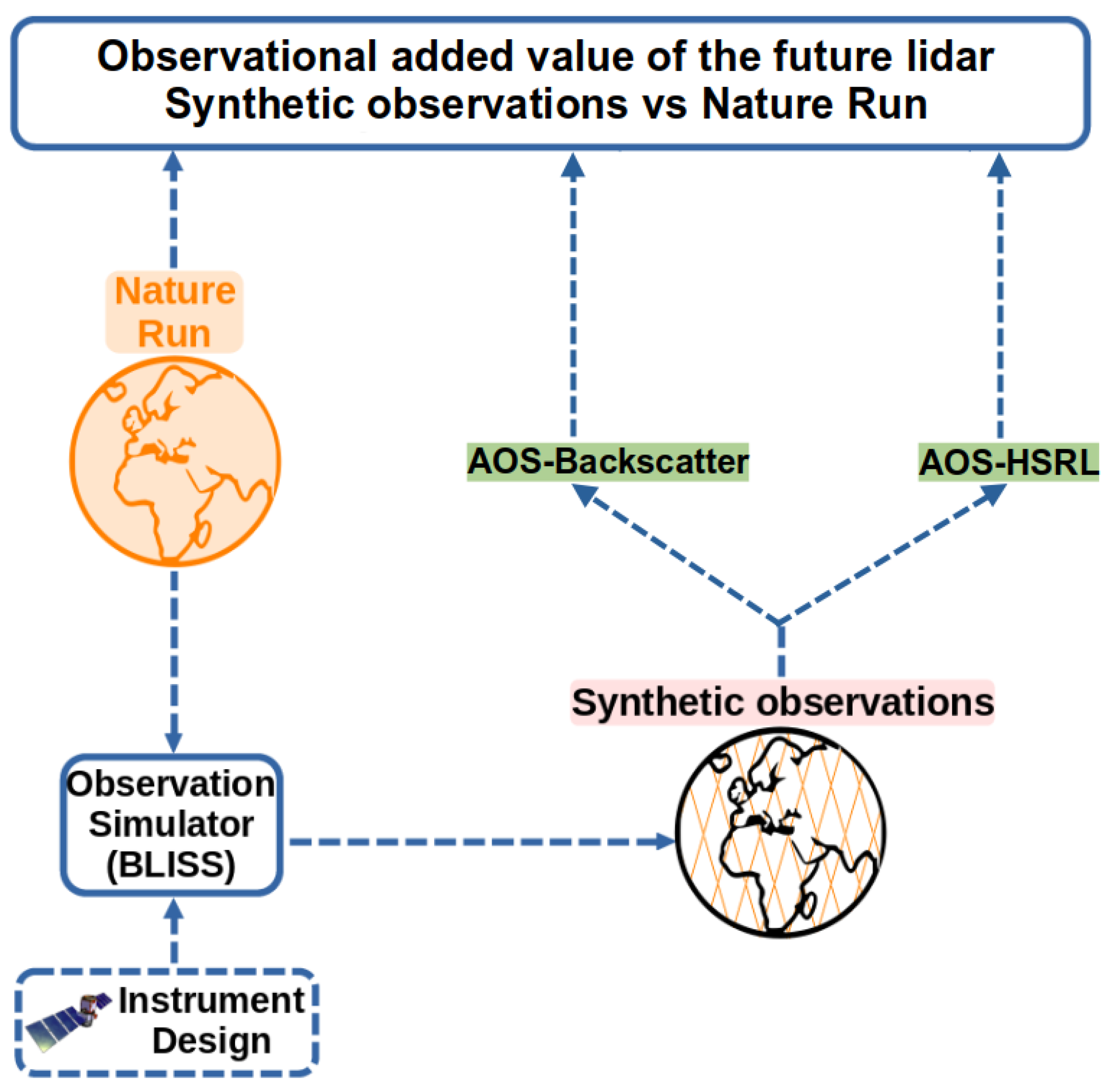
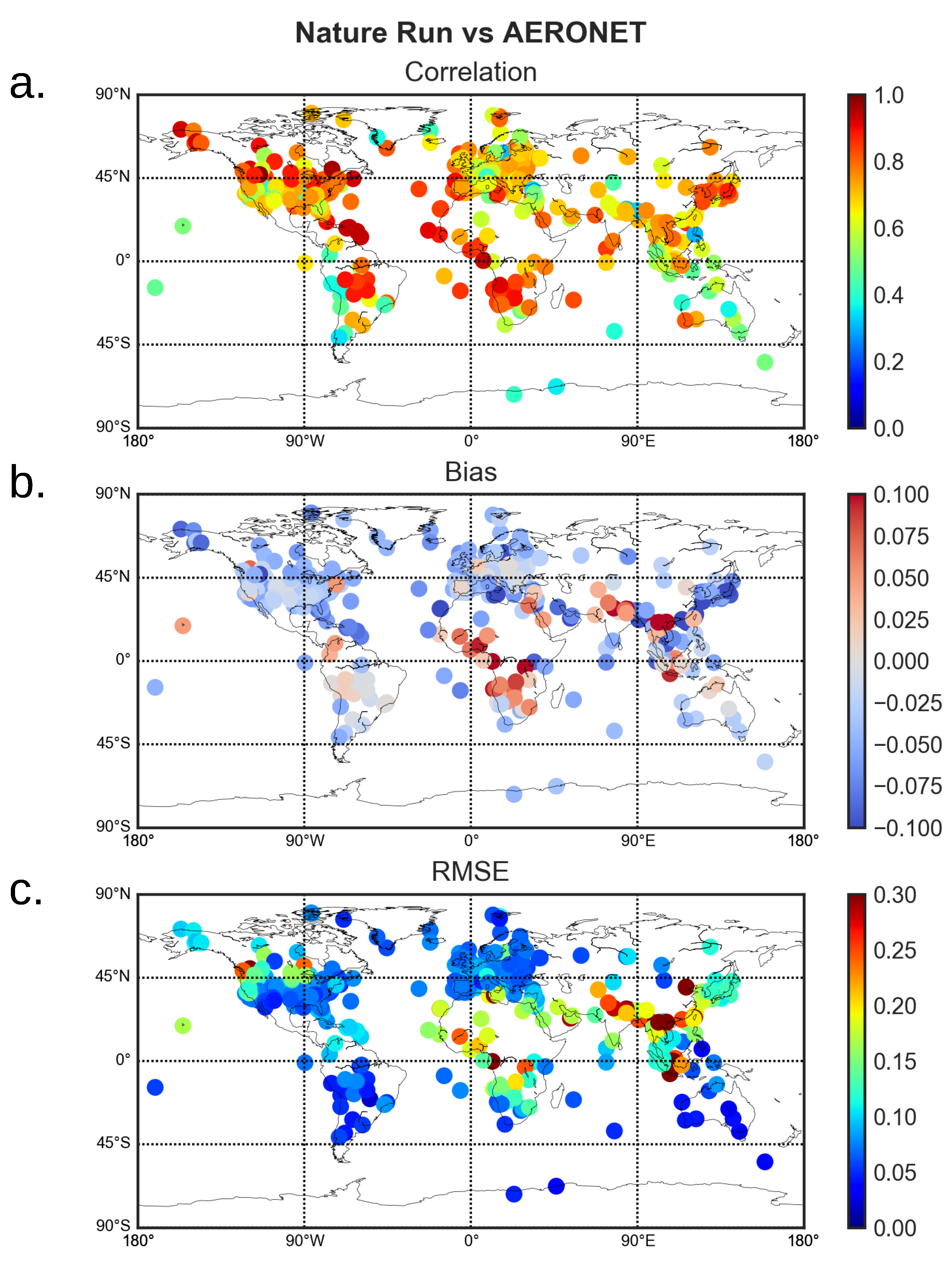

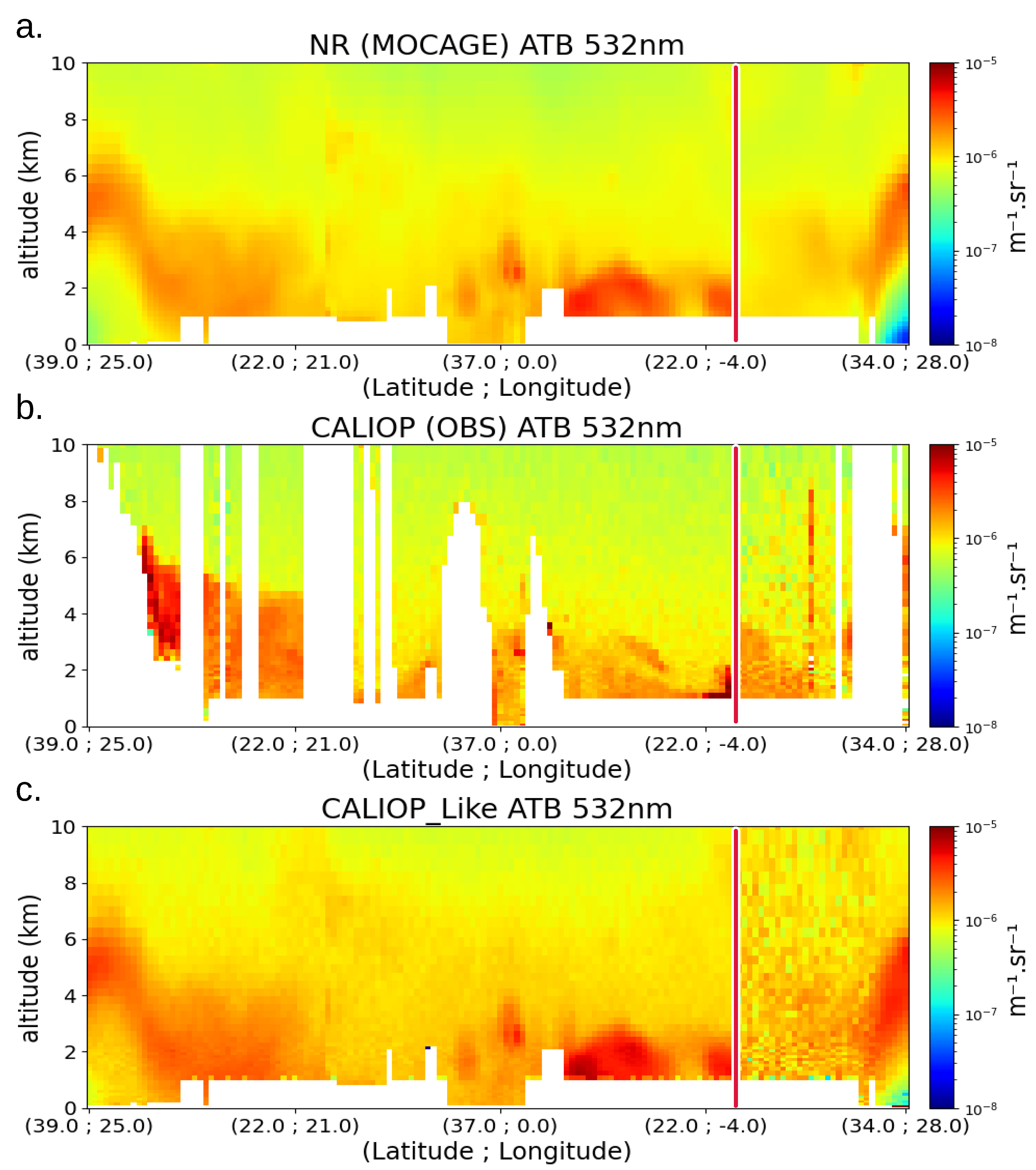
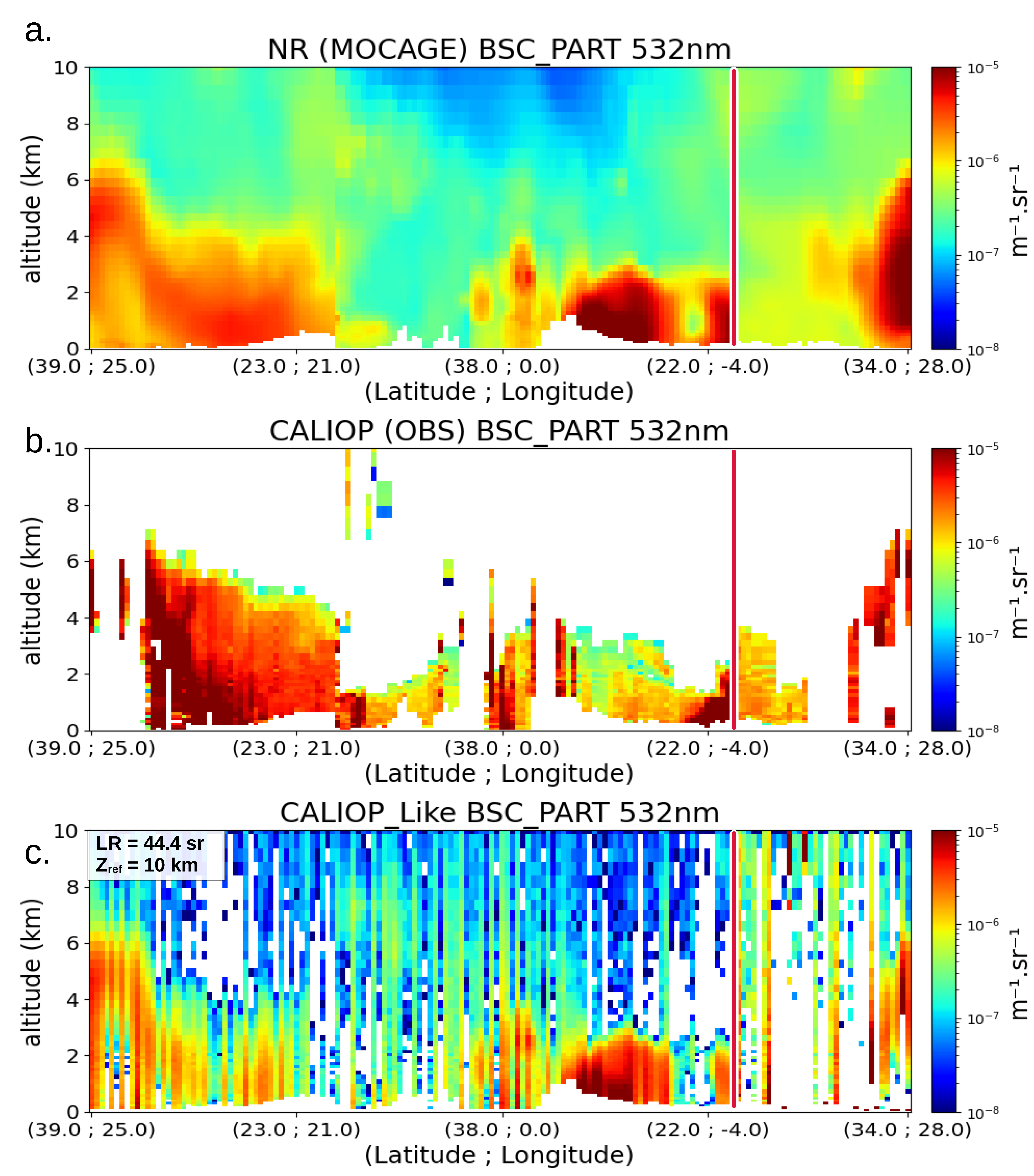
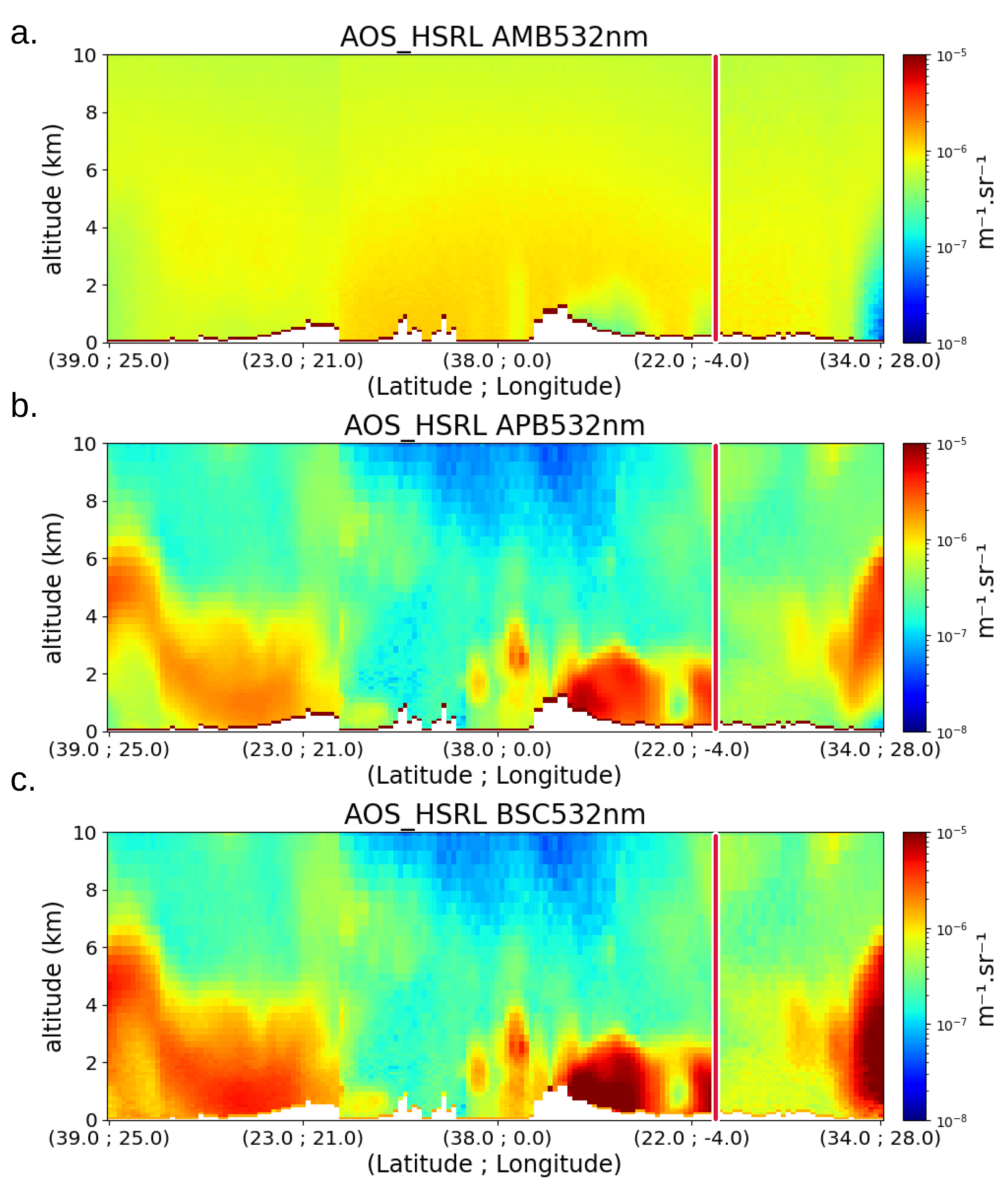
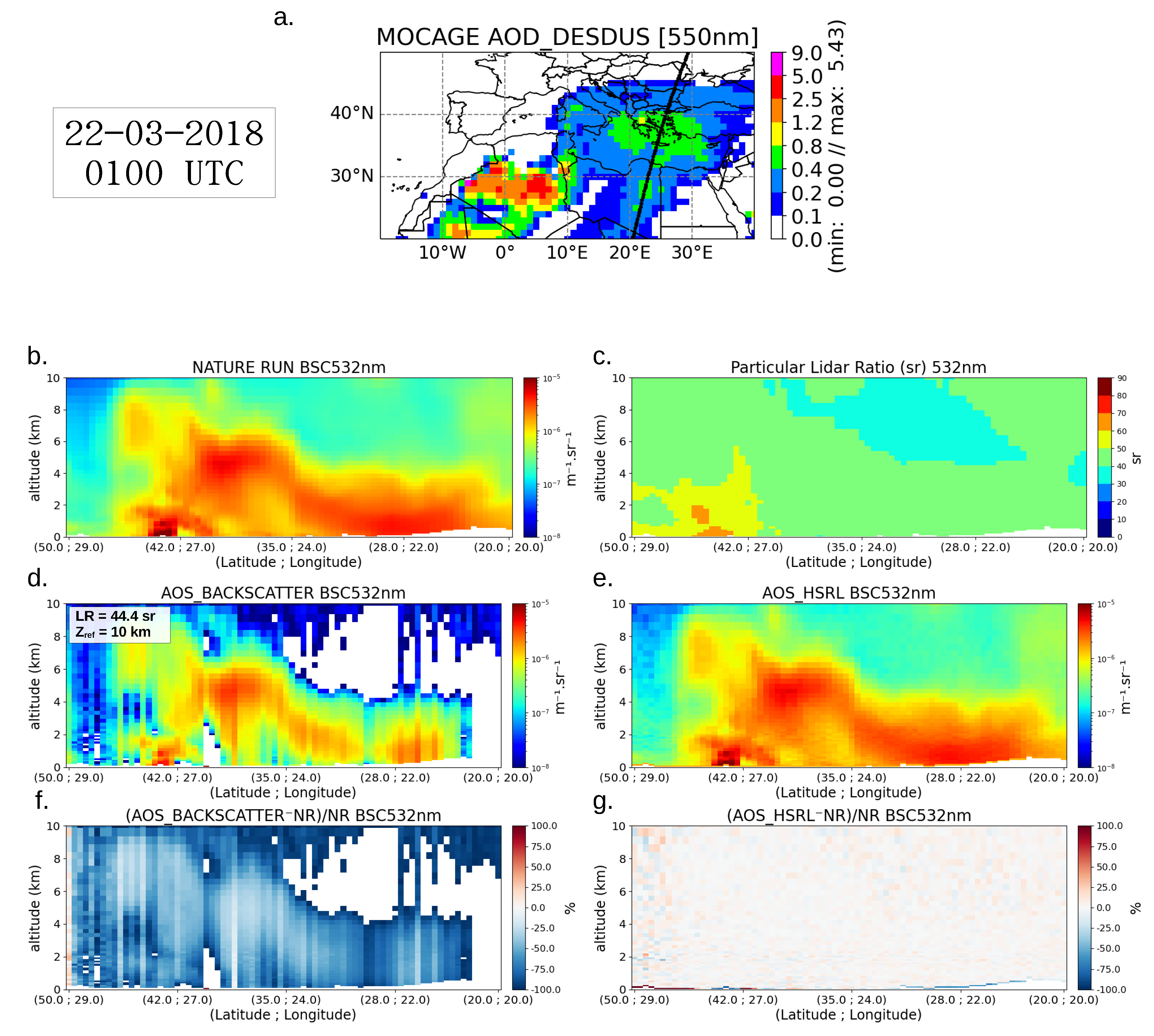
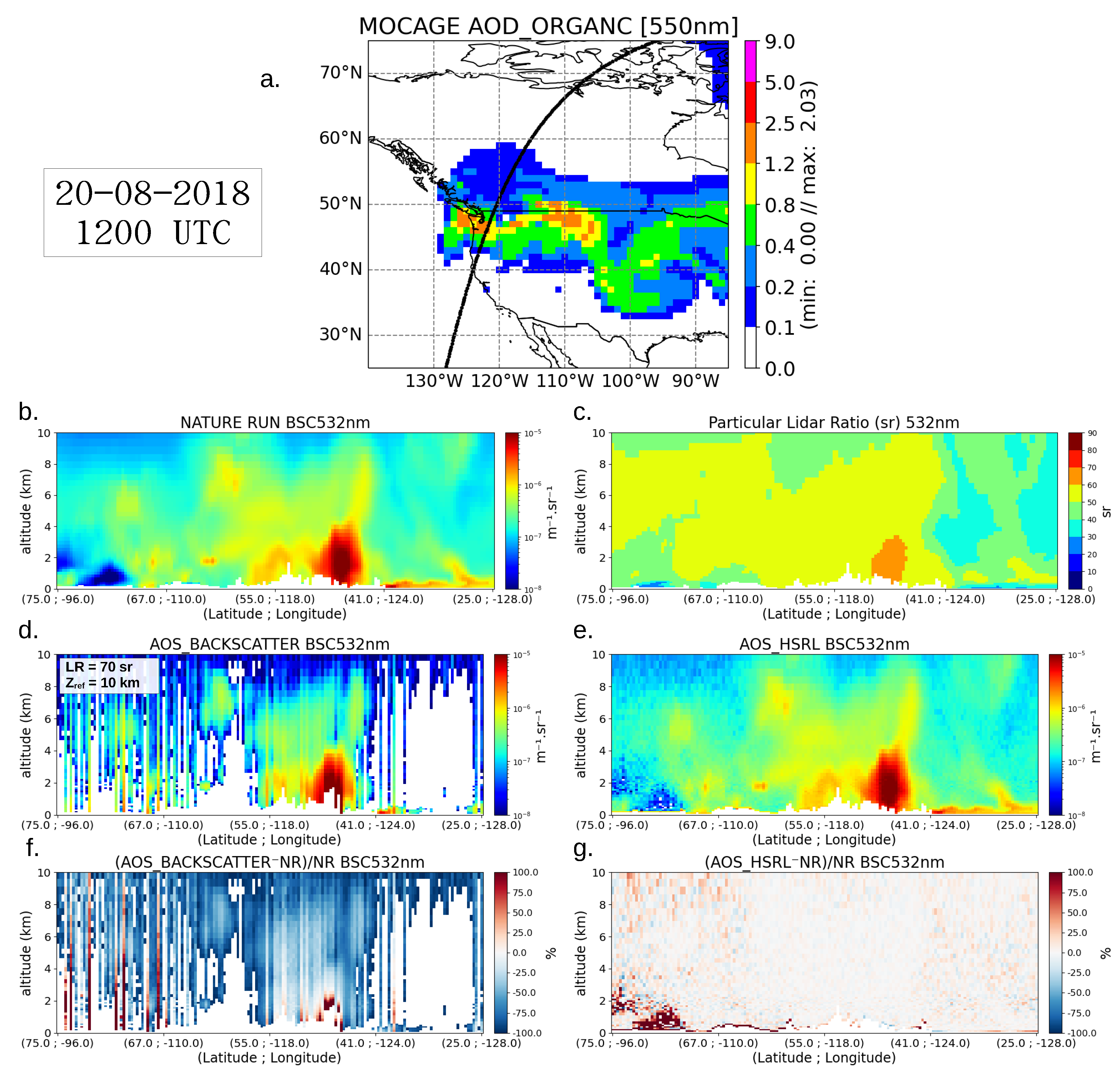


| LR (sr) | CM 1 | DD | PC 2/S 3 | CC 4 | PD 5 | DM 6 | ES 7 |
|---|---|---|---|---|---|---|---|
| 532 nm | |||||||
| 1064 nm |
| Parameter | CALIOP_Like | AOS_Backscatter | AOS_HSRL |
|---|---|---|---|
| Altitude (km) | 705 | 450 | 450 |
| Wavelength (nm) | 532 | 532 | 532 |
| Emitted power (W) | 2.2 | 8 | 8 |
| Pulse duration (ns) | 20 | 15 | 15 |
| Repetition Frequency (Hz) | 20 | 70 | 70 |
| Telescope diameter (m) | 1 | 1 | 1 |
| lidar LOS zenith angle (°) | 3 | 3 | 3 |
| Filter bandwidth (nm) | 0.63 | 0.1 | 0.1 |
| HSRL filter | No | No | Yes |
Disclaimer/Publisher’s Note: The statements, opinions and data contained in all publications are solely those of the individual author(s) and contributor(s) and not of MDPI and/or the editor(s). MDPI and/or the editor(s) disclaim responsibility for any injury to people or property resulting from any ideas, methods, instructions or products referred to in the content. |
© 2023 by the authors. Licensee MDPI, Basel, Switzerland. This article is an open access article distributed under the terms and conditions of the Creative Commons Attribution (CC BY) license (https://creativecommons.org/licenses/by/4.0/).
Share and Cite
Cornut, F.; El Amraoui, L.; Cuesta, J.; Blanc, J. Added Value of Aerosol Observations of a Future AOS High Spectral Resolution Lidar with Respect to Classic Backscatter Spaceborne Lidar Measurements. Remote Sens. 2023, 15, 506. https://doi.org/10.3390/rs15020506
Cornut F, El Amraoui L, Cuesta J, Blanc J. Added Value of Aerosol Observations of a Future AOS High Spectral Resolution Lidar with Respect to Classic Backscatter Spaceborne Lidar Measurements. Remote Sensing. 2023; 15(2):506. https://doi.org/10.3390/rs15020506
Chicago/Turabian StyleCornut, Flavien, Laaziz El Amraoui, Juan Cuesta, and Jérôme Blanc. 2023. "Added Value of Aerosol Observations of a Future AOS High Spectral Resolution Lidar with Respect to Classic Backscatter Spaceborne Lidar Measurements" Remote Sensing 15, no. 2: 506. https://doi.org/10.3390/rs15020506







